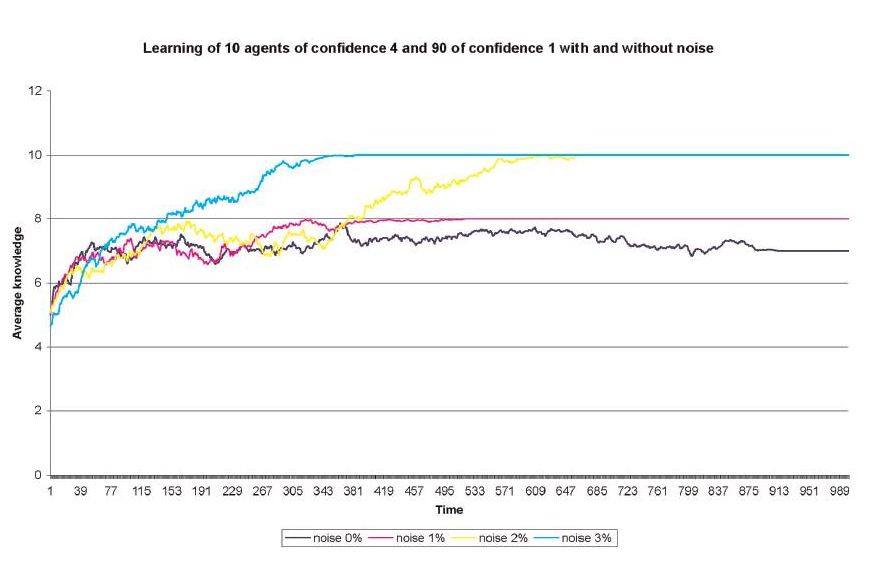As a young boy, I was familiar with the books and movies of the Italian pop-philosopher Luciano De Crescenzo. “The question mark”, was one of his favourite quotes, “is the symbol of good. The exclamation mark, the symbol of evil. When you meet someone who has doubts, you can take it easy. That means he’s a good person, someone broad-minded and tolerant… But if you meet someone who is overconfident, someone of unshakable faith – you should be afraid.” (Here is how it sounds in Italian, in this excerpt from his 1984 film Thus spake Bellavista).
A couple of recently published articles seem to make the same point – but in a more formal way. The first one has been published in Science on December 16th, 2011. Based on observations of animal behaviour (I know, I know… but bear with me please), the authors emit the educated guess that, within a human group, less-informed individuals are able to balance overly polarized political views.
Couzin, I., Ioannou, C., Demirel, G., Gross, T., Torney, C., Hartnett, A., Conradt, L., Levin, S., & Leonard, N. (2011). Uninformed Individuals Promote Democratic Consensus in Animal Groups Science, 334 (6062), 1578-1580 DOI: 10.1126/science.1210280
Uninformed individuals are instrumental to consensus-building and they contribute to functional democratic political processes (well, at least in the one vision of democracy that considers polarized pluralism as dysfunctional). “Conflicting interests among group members”, explain the authors, “are common when making collective decisions, yet failure to achieve consensus can be costly. Under these circumstances individuals may be susceptible to manipulation by a strongly opinionated, or extremist, minority”. Individuals who are uninformed or exhibit weak preferences, might seem to be particularly vulnerable to such manipulations. But here’s the surprise: the authors demonstrate that “for a wide range of conditions, a strongly opinionated minority can dictate group choice, but the presence of uninformed individuals spontaneously inhibits this process, returning control to the numerical majority”.

As you can see in fig. 1, even with increasingly stronger minority preferences (ω2), if the number of uninformed individuals (N3) is high enough, majority consensus can be reached. Hurrah for the uninformed then… if by “uninformed” we mean people who have weaker preferences and/or are less vocal in expressing them. And this is when we realize that, ultimately, what we’re talking about here is people who have doubts about a certain point.
So the actual matter is not really information, but confidence. And the second article, published online before print in the journal Simulation, comes in handy. The authors set out to build a model of influence where social agents’ beliefs are based on an “objective reality” (I know, I know… but bear with me please), such as the properties of an environment, e.g. the climate or the availability of natural resources.
Rouchier, J., & Tanimura, E. (2011). When overconfident agents slow down collective learning Simulation DOI: 10.1177/0037549711428948
The perception of their environment is not direct, though. The only thing our agents know is that the more correct is their belief, the more successful the resulting actions. So doubt – or lack thereof – comes into the equation, as agents “can influence each other when they perform a joint action. They are not only defined by individual beliefs, but also by idiosyncratic confidence about their belief: this means that they are not all willing to engage in an action with agents with a different belief and to be influenced by them”.
Using agent-based simulation, authors initially describe the influence and learning system of a population where individuals display the same confidence levels. Then they move on to study the case of “heterogenous confidence”, i.e. when in a pair of interacting agents, one is more confident, the other more uncertain. And the outcome is that “the distribution of confidence in the group has a major impact on the speed and quality of collective learning and in particular that a small number of overconfident agents can prevent the whole group from learning properly”.

Table 1 clearly identifies a threshold around values of confidence comprised between 7 and 8, after which complete learning isn’t attained anymore and average knowledge of the environment (in absence of learning) drops rapidly towards 50%.
To counter the effects of overconfident agents on poor collective learning, we have to let the doubtful rule. One way of achieving this is by introducing noise in the choice of the leader (i.e. increasing the possibility for less confident agents to influence others). Figure 2 illustrates the – now expected – result: the higher the noise, the more often doubt prevails, the better the collective learning.
